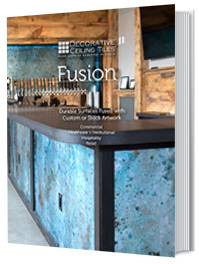Tin Ceiling Installation Instructions and Tips
Written by Milan Jara on 20th Aug 2022

Installing tin ceiling tiles is easy even for beginners. Check out these handy tin ceiling installation instructions and tips for success in your project.
When installing real tin ceiling tiles, you don't have to worry too much about getting it wrong since they are easy to install using the nail-up method.
However, you must get the basics right to ensure you're installing tin ceiling tiles correctly and in the shortest time possible. This post provides handy tin ceiling installation instructions and tips you must follow to make the process easier and highly successful.
Tin Ceiling Installation Tips
To install nail-up tin ceiling tiles like a pro, use the tips below.
1. Use Plywood Substrate, No Matter the Ceiling Surface
Regardless of the ceiling material, you must use a plywood substrate for the nail-up ceiling tiles.
The plywood acts as a secure nailing surface for the tiles, whether your ceiling surface is plaster, exposed joists, or drywall.
2. Order Samples First
Tin ceiling tile comes in many different patterns, colors, and designs. You can use many criteria to choose the tiles for your room, such as buying tiles whose color matches other features in your room. The shades can be lighter or darker.
You can also choose tiles whose color contrasts with other features in the room, like walls and curtains. A third alternative is to mix tin tiles of different colors.
If you can't decide on the best tile, you can order sample tin ceiling tiles and try them out first to see which best fits your place.
3. Opt for Custom Tin Tiles

Sometimes, you won't like any of the varieties of tin ceiling tiles we have available. You might want a different style, pattern, design, or color to match your preferences.
In other cases, you may be looking for antique tin ceiling tiles that are no longer in circulation.
At Decorative Ceiling Tiles, we can make custom tin ceiling tiles for you to replicate antique tiles or match your preferences.
4. Consider Sealing Both Faces of the Tiles
Sealing ceiling tiles is necessary for maintaining the original finish and protecting them from moisture.
You can buy our powder-coated tin tiles that are ready to install or apply a thin coat of car paint or oil-based paint on your tiles.
The third sealing option is applying a thin coat of clear varnish or polyurethane sealant. The seal preserves your ceiling tiles and makes them look fresh for years to come.
Since you need to seal both sides of each tile, you must seal them before installing them.
5. Use Tin Cornices or Crown Molding to Hide Ugly Edges

It isn't that you'll cut ugly tile edges, but you should cover the edges of the perimeter tiles with matching tin moldings or cornices.
The overall look of a filler strip is better than leaving the wall-ceiling joint bare with exposed tile edges.
What You'll Need for Tin Ceiling Installation
To successfully install real tin ceiling tiles, you'll need the following materials and tools:
- Nail-up tin ceiling tiles
- Level
- Gloves
- Shims
- Commercial-grade plywood with ½ or ⅜" thickness
- T-square or framing square
- Chalk line
- Circular saw/tin snips/scissors/guillotine cutters for cutting the tin tiles
- Clear silicone caulk
- Caulking gun
- Long strings
- Conehead nails
- Portable drill and ⅜" drill bit for drilling holes for nails into delicate plaster, studs, or joists
- Small rectangular wood block
- Tin fillers (you may or may not need them)
- Tape measure
- Oil-based paint, car paint, or polyurethane sealant
- Paint applicator, such as a handheld paint sprayer
- Pencil compass for making circular outlines on tiles and plywood for holes to be made
- Pencil for marking where to cut tiles and plywood
- Jigsaw for cutting fixtures in plywood
- Duct tape (optional)
- Stepladders/Rolling work platform/Scaffolding
- Holesaw (hole cutter) for cutting holes into the tiles
- Stud finder (if installing tiles on drywall)
- Hammer
- Brad nailer (optional - for driving nails to fix the plywood)
- Belt sander/chisel
- T-brace for holding plywood in place when nailing it
Tin Ceiling Installation Instructions
Here's how to hang tin ceiling tiles:
1. Secure the Plywood on the Ceiling Surface
Before installing the plywood, clean the ceiling surface so it is free from dust, grease, moisture, and debris.
Ensure the surface is level, without low or high areas. Run a tight string from one side to the other and hold it close to the surface. Do this in several places along the room's width and length. Use a belt sander or chisel if you need to even out any parts. Alternatively, you can install shims.
Check for fixtures like lighting boxes and fans that you'll need to cut out on the plywood. Cut the spaces using the jigsaw.
Install the plywood so each end is held to the surface with a nail driven into the holes you made with the drill.
2. Locate the Center of the Ceiling
The center of the ceiling is most likely already marked by a light or ceiling fan. If not, stretch a string between nails driven into the plywood from each diagonal. Their meeting point will be the center.
At the center marked, draw two perpendicular lines to make four quadrants on the ceiling.
Locate the centers of the perimeter walls. Using a chalk line, make a line from the center of one wall across the ceiling to the center of the opposite wall.
Use the width of the tiles to guide you on the placement of other chalk line snaps across the perimeter walls. These snap lines make straight lines on the plywood, showing you where to install the tiles. Check that you placed all the snap lines correctly.
3. Nail Up the Field Tiles
Start installing the field tiles by placing the first tin tile in the center of the ceiling, lining up one of its corners with the perpendicular lines you made.
Install the other tiles in parallel rows, making sure to overlap them in the same direction if they have overlapping edges. Nail one edge of each tile and leave the overlapping edge free to make room for fitting together with the incoming tile.
To eliminate possible gaps in the metal tiles, install the exposed edges of the overlaps facing away from the door.
If the tiles have a directional pattern, ensure you install all the tiles in the right direction.
Be sure to cut out holes on the tiles for fixtures like lighting, fans, or vents.
4. Nail Up the Perimeter Tiles

Once you reach the edges of the ceiling, you'll need to cut tiles to cover the remaining surface.
Cut each filler tile carefully, keeping in mind that its overlapping edge must overlap with the adjacent tile. The cut edges of the tiles will lie flush against the wall.
Once all the tiles are in place, seal the seams or gaps. Hold the wood block at a 45° angle against the groove along adjacent tiles and gently tap its top with a hammer to close the gaps.
Seal the ceiling seams using transparent silicone caulk. You can finish the ceiling edges by installing tin molding or cornices.
The tin fillers will come in handy as trim to fill gaps in places with odd measurements. Alternatively, you can use them to create transitions or borders between sections of the ceiling that may have differentiated tiles.
Closing Thoughts
We hope you've found these tin ceiling installation instructions and tips helpful for your project. If you need a tin ceiling installation expert, you can always find one in our database .




